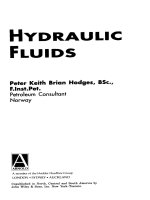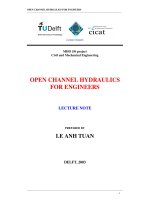C8 hydraulic fracturing
Bạn đang xem bản rút gọn của tài liệu. Xem và tải ngay bản đầy đủ của tài liệu tại đây (1.46 MB, 28 trang )
5/9/2014
Designed & Presented by
Mr. ĐỖ QUANG KHÁNH, HCMUT
03/2014
Đỗ Quang Khánh – HoChiMinh City University of Technology
Email: or
1
Content & Agenda
Ref:
Recent Advances In Hydraulic Fracturing, John L. Gidley, Stephen A. Holditch, Dale E.
Nierode & Ralph W. Veatch Jr.,1991
Reservoir Stimulation, 3e – Economides & Nolte
Petroleum Production Systems - Economides et al., 1994
Production Operations: Well Completions, Workover, and Stimulation -Thomas O. Allen,
Alan P. Roberts,1984
1
5/9/2014
Introduction
Objective: to create highly conductive paths some
distance away from the wellbore into the reservoir.
o Execution of a hydraulic fracture involves
the injection of fluids at a pressure sufficiently
high to cause "tensile failure" of the rock.
o At the fracture initiation pressure, often known
as the "breakdown pressure“, the rock opens.
o As additional fluids are injected, the opening
is extended and the fracture propagates.
o A properly executed hydraulic fracture results in a "path," connected to the well,
that has a much higher permeability than the surrounding formation.
Introduction
o Minimum hydraulic fracturing candidate well selection screening criteria
2
5/9/2014
LENGTH, CONDUCTIVITY, & EQUIVALENT SKIN EFFECT
o Every hydraulic fracture can be characterized by its:
– length ;
– conductivity;
– related equivalent skin effect
o In almost all calculations, the fracture length, which must be the conductive length and not the created
hydraulic length, is assumed to consist of two equal half‐lengths, xf, in each side of the well.
- beside, consider the penetration ratio: Ix = 2 xf / xe.
LENGTH, CONDUCTIVITY, & EQUIVALENT SKIN EFFECT
o The dimensionless fracture conductivity: CfD = kf W / k Xf
= (Ability of fracture to deliver oil/gas to well)/(Ability of formation to deliver gas into the fracture)
> 30 (Infinitely Conductive Fracture)
2 xf
w
o -Related to Prat’s a (called the relative capacity): CfD = л/2a
where:k is the reservoir permeability, k f is the fracture permeability, and w is the propped fracture width.
o Fracture skin effect varying with fracture conductivity
(Cinco-ley and Samaniego, 1981)
3
5/9/2014
LENGTH, CONDUCTIVITY, & EQUIVALENT SKIN EFFECT
o Equivalent skin effect, sf, & Improve Productivity Index J:
o The equivalent skin effect, sf: the result of a hydraulic fracture of a certain length and conductivity
& can be added to the well inflow equations in the usual manner.=> sf is pseudo skin factor
used after the treatment to describe the productivity:
2kh
2kh
1
J D
J
B ln[ re ] 0.75 s
B
f
rw
o Prats (1961): the concept of dimensionless effective wellbore radius r’wD
in a hydraulically fractured well:
LENGTH, CONDUCTIVITY, & EQUIVALENT SKIN EFFECT
for small values of a, or high conductivity fractures, the r’wD is equal to 0.5, leading to r’w
= xf /2; which suggests that for these large-conductivity fractures the reservoir drains to a
well with an effective wellbore equal to half of the fracture half-length.
Since the effective wellbore must be as large as possible, values of ”a” larger than unity m
ust be avoided because the effective wellbore radius decreases rapidly.
=> hydraulic fractures should be designed for a < 1 or CfD > 1.6
for large values of a, the slope of the curve is equal to 1, implying a linear relationship
between r’w and a that is approximately r’w = kf w/4k; Which suggest that for low
conductivity fractures, the increase in r’w does not depend on fracture length but instead
on fracture permeability-width product,which must be maximized.
4
5/9/2014
LENGTH, CONDUCTIVITY, & EQUIVALENT SKIN EFFECT
o What length or fracture permeability is desirable in hydraulic fracturing?
• Low‐permeability reservoirs, leading to high‐conductivity fractures,
would benefit greatly from length.
• Moderate‐ to high‐permeability reservoirs, naturally leading to
low‐conductivity fractures, require good fracture permeability
(good quality proppant and nondamaging fracturing fluid).
Notation
rw
wellbore radius, m (or ft)
r'w
Prats’ equivalent wellbore radius due to fracture,
m (or ft)
f s f ln
xf
rw
Cinco-Ley-Samanieggo factor, dimensionless
sf
the pseudo skin factor due to fracture,
dimensionless
rw
xf
Prats' dimensionless (equivalent) wellbore
radius
But JD is the best
5
5/9/2014
Pseudo-steady state Productivity Index
q Jp
Production rate is proportional to drawdown, defined as average
pressure in the reservoir minus wellbore flowing pressure
Circular:
2kh
J D p
q
B
1
JD
r 3
ln e s
rw 4
Drawdown
Dimensionless
Productivity Index
Pseudo-skin, equivalent radius, f-factor
J
2kh
r
B ln 0.472 e s f
rw
J
or
2kh
r
B ln 0.472 e
r 'w
Prats
f (C fD )
J
2πkh
0.472re
x
Bμ ln
s f ln f
xf
rw
2πkh
0.472re
Bμ ln
f
xf
Cinco-Ley
6
5/9/2014
Dimensionless Productivity
Index, sf and f and r’w
JD
1
ln 0.472
re
sf
rw
or
1
JD
ln 0.472
re
r 'w
Prats
f (C fD )
1
1
JD
0.472re
x
0.472re
f
ln
s f ln f ln
x
xf
rw
f
Cinco-Ley
Factor f
(after Cinco-Ley and Samaniego, 1981)
7
5/9/2014
LENGTH, CONDUCTIVITY, & EQUIVALENT SKIN EFFECT
oExample:
8
5/9/2014
Proppant placement into formation
We can use the propping
agent to increase fracture
length or width.
Tip screenout (TSO)
techniques:
fracture width can be
increased without
increasing the fracture
extent.
How should we select the optimum fracture length
and width under the constraint that the proppant
volume is given?
Fracture half length & CfD,opt
the optimum CfD,opt = 1.6 is a given constant for any reservoir
and any fixed amount of proppant.
9
5/9/2014
Optimum fracture dimensions
Once we know the volume of proppant that can be placed into one wing of the fracture, Vf, we can
calculate the optimum fracture dimensions as
Moreover, since
and yopt - 0.75 = 0.869, we obtain
Fracture Orientation & In situ stress
Least Principal Stress
Horizontal fracture
Least Principal Stress
Vertical fracture
The fracture will be oriented at a 90-degree angle to
the least principal stress.
10
5/9/2014
Fracture Orientation & In situ stress
Role of Formation Properties in Fracturing
The formation properties that are known to influence a fracture’s
growth pattern, including its height, are:
Young's modulus
Poisson's ratio
Tensile strength
Fracture toughness
Permeability
Porosity
Poroelasticity constant
11
5/9/2014
Rock Properties
Plane Strain Modulus:
Shear modulus:
Rock Properties
Tensile Strength: The maximum stress that a material can tolerate without rupture in a uniaxial tensile experiment is
the tensile stress.
Fracture Toughness: The critical value of the stress intensity factor, or fracture toughness, characterizes a rock’s
resistance to the propagation of an existing fracture.
Permeability: The larger the fluid leakoff, the less driving force is available for fracture growth.
The Poroelastic Constant, , is defined by the relation:
where K is the bulk modulus (ratio of hydrostatic pressure to volumetric strain) of the dry rock material and Ks is the
same measured in a saturated sample.
12
5/9/2014
Other elasticity constants
Required
\
E,
Known
Shear modulus, G
Young's modulus, E
Poisson ratio,
Plane strain modulus, E'
E
21
G,
G
G
2G 1
E
E
1 2
E ,G
2G
1
E
E 2G
2G
4G 2
4G E
Poroelasticity and Biot’s constant
σ σ αp
Total Stress = Effective Stress + a[Pore Pressure]
Grains
Force
Pore Fluid
Biot’s constant
a ~ 0.7
13
5/9/2014
Vertical Profile of Minimum Stress
The effective stress, s’, is the
absolute stress minus the pore
pressure (p) weighted by the
poroelastic constant (a):
minimum effective horizontal stress
total horizontal stress
1) Poisson ratio changes from layer to layer
2) Pore pressure changes in time
0
-500
Ground Surface
Critical Depth
977 m
-1000
0
-500
-1500
-1000
-2000
-1500
-2500
-2000
-3000
0
20x106
40x106
60x106
Stress, Pa
Current Depth , m
Depth from original ground surface, m
Crossover of Minimum Stress
-2500
80x106
14
5/9/2014
Stress Gradients
Overburden gradient gradient
Slope of the Vertical Stress line
1.1 psi/ft
Frac gradient
Basically the slope of the minimum
horizontal stress line
0.4 - 0.9 psi/ft
Extreme value: 1.1 psi/ft or more
STRESS
oExample:
15
5/9/2014
Fracturing Pressure
Fracture Initiation Pressure or breakdown pressure is the peak value of the pressure appearing
when the formation breaks down and a fracture starts to evolve. Usually it is approximated by
where smin is the minimum horizontal stress, smax is the maximum horizontal stress, T is the tensile
stress of the rock material, a is the poroelasticity constant and po is the pore pressure.
Fracture Propagation Pressure is the stabilized value of the injection pressure for a longer period of
time during which the fracture is evolving.
Detection of formation
breakdown from a steprate test
16
5/9/2014
Fracturing Pressure (MiniFrac)
Fracture Closure Pressure. After a fracture calibration treatment, which is carried out without injecting
proppant material, the fracture volume gradually decreases because of leakoff (and also because of
possible back flow, if the injected fluid is flowed back through the well).
(1) breakdown pressure;
(2) fracture propagation pressure;
(3) instantaneous shut-in pressure;
(4) closure pressure;
(5) fracture reopening pressure;
(6) closure pressure from flow-back;
(7) asymptotic reservoir pressure;
(8) rebound pressure
Leakoff
Fluid leakoff is controlled by a continuous build-up of a thin layer, or filter cake, which
manifests an ever-increasing resistance to flow through the fracture face.
The leakoff velocity, VL , is given by the Carter equation:
uL
CL
t
Where CL is the leakoff coefficient (length/time0.5) and t is the time elapsed since the
start of the leakoff process. The ideas behind Carter's leakoff coefficient are that:
o
if a filter-cake wall is building up, it will allow less fluid to pass through a unit area in unit time;
and,
o
the reservoir itself can take less and less fluid if it has been exposed to inflow.
17
5/9/2014
AL
uL
CL
t
VLost
= S p 2CL t
AL
units :
m mm
Lost volume per unit surface, m
Fluid Loss in Lab
0.007
0.006
0.005
0.004
0.003
y = 0.0024 + 0.000069x
0.002
Sp
0.001
0
0
CL
Sp
10
2CL
20
30
40
50
60
Square root time, t1/2 (s1/2)
m
s
unit : m
unit :
or
m3
m2 s
Description of leakoff through flow in porous
media and/or filtercake build-up
Concept of leakoff coefficient
uL
m m / s1 / 2
1/ 2
s
s
Where are those “twos” coming from?
Integrated leakoff volume:
CL
t
VL 2 AC L t
Leakoff Width
wL
What is the physical meaning?
VL
2CL t
AL
m mm
18
5/9/2014
Definition of injection rate, fracture area
and permeable height
Width Equations
Perkins-Kern-Nordgren (PKN)
Kristianovich-Zheltov-Geertsma-DeKlerk (KGD)
19
5/9/2014
Comparison of PKN and KGD width equations
The crossover occurs approximately at
the point at which a "square fracture"
has been created, i.e., when
For the small fracture extent, the
physical assumptions behind the KGD
equation are more realistic.
For the larger fracture extent, the PKN
width equation is physically more
sound.
Radial (Penny-shaped) Width Equation
20
5/9/2014
No-leakoff Behavior of Width Equations
Perkins-Kern-Nordgren model
Geertsma and deKlerk model
Types of Fluids
Water-Base Fluids
natural guar gum (Guar)
hydroxypropyl guar (HPG)
hydroxyethyl cellulose (HEC)
carboxymethyl hydroxyethyl cellulose (CMHEC)
Oil-Base Fluids
Acid-Base Fluids
Used in limestones or dolomitic formations.
Emulsions
Lease oil and gelled oils.
Mixtures of oil and an aqueous material (either water or acid).
Gas/Foam Fluids
Specialized emulsions using nitrogen or carbon dioxide gas as the inner phase of an aqueous mixture.
21
5/9/2014
Fracturing Additives
Bacteria control agents
Gypsum inhibitors
Breakers
N2and CO2 gases
Clay-stabilizing agents
Scale inhibitors
Demulsifying agents
Sequestering agents
Dispersing agents
Sludge inhibitors
Fluid loss additives
Surfactants
Foaming agents
Temperature-stabilizing agents
Friction loss reducers
Water blockage-control agents
Proppant Pack Permeability & Fracture Conductivity
Proppant duties:
Be capable of holding the fracture faces apart
must be long lasting.
be readily available, safe to handle, and relatively inexpensive.
22
5/9/2014
Types of Proppants
Two major categories:
Naturally occurring sand
White Sand ("Ottawa" sand)
Manufactured proppants
Sintered Bauxite
Intermediate Strength Proppants
Resin Coated Proppants
A typical proppant selection guide
23
5/9/2014
Design Logics
Height is known (see height map)
Amount of proppant to place is given (from NPV)
Target length is given (see opt frac dimensions)
Fluid leakoff characteristics is known
Rock properties are known
Fluid rheology is known
Injection rate, max proppant concentratrion is given
How much fluid? How long to pump? How to add proppant?
Key concept: Width Equation
Fluid flow creates friction
Friction pressure is balanced by injection pressure
Net pressure is positive
Fracture width is determined by net pressure and
characteristic dimension (half length or half height)
The combination of fluid mechanics and solid mechanics
24
5/9/2014
Two approximations:
Perkins-Kern-(Nordgren)
Vertical plane strain
characteristic half-length ( c ) is half height, h/2
elliptic cross section
Kristianovich-Zheltov - (Gertsmaa-deKlerk)
Horizontal plane strain
characteristic half length ( c ) is xf
rectangular cross section
Width Equations (consistent units)
Perkins-Kern-Nordgren PKN
width: w, wo, wwell,o
viscosity:
inj. rate (1 wing): qi
half-length: xf
plain-strain modulus: E'
height: hf
Vf = w(h f x f )
qi x f
ww,0 = 3.27
E'
1/ 4
w 0.628ww,0
Kristianovich-Zheltov
Geertsma-De-Klerk KGD
qi x 2f
ww = 3.22
E' h
f
w 0.785ww
1/ 4
25









